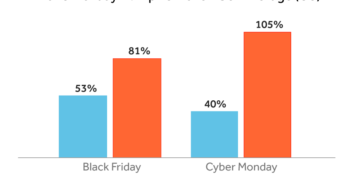In recent years the Black Friday and Cyber Monday online sales have become an essential part of the shopping calendar. A weekend of cut price toys, clothing and big-budget tech draws an influx of shoppers and creates a significant spike in retailers’ revenues.
Yet, even with significant fortunes at stake, some retailers simply don’t get it right and consumers regularly face a variety of technical problems during the Black Friday weekend. Major retail sites, including Macy’s, QVC, Walmart, Victoria’s Secret and Newegg, have all experienced outages during the period, thanks at least in part to an enormous boost in web traffic.
The lost revenue, customer dissatisfaction and reputational damage of these technical issues can be significant, and the stores behind the biggest holiday web fails often make national headlines – for all the wrong reasons.
So how do retailers get ready for the next big sales rush, and make sure they capitalise on the big Black Friday opportunity?
1. Prioritise testing
Put simply, web and mobile development teams are responsible for the quality of user experience and reliability of apps and websites – and this can make or break Black Friday for retailers.
The received wisdom is to avoid shipping big bold new features, to tidy up any fragile areas of the codebase and to ensure the whole team is clear on how to manage the busy periods, including things like rotas, emergency contingency and support.
Developers must ensure that all tests (functional, non-functional – performance, security, accessibility, UX etc.) are running as part of their continuous testing workflow against a production environment with ongoing monitoring to identify production hiccups. If an app or mobile site relies on a third party, like Facebook, this too should be covered in your test strategy.
Quality dashboards with smart insights for fast feedback will enable a timely response to issues whenever they occur. For forward looking firms, machine learning and AI helps organization slice and dice data, monitor trends, and enhance overall productivity (both for dev and test)
Getting all this right is complex but there are methodologies that can help.
Rather than build a device lab in-house, the savviest firms are now opting to leverage real devices in the cloud. It’s quicker, easier to maintain, enables agility, and costs less. Unit tests, early-stage tests, and tests that don’t rely heavily on hardware specifications can be run on emulators. And more complex, late-stage testing can be done on real devices, but in the cloud.
2. The importance of a continuous approach
The most fundamental mistake development teams can make is to view the holiday season as a special sprint – a one off event which they must race to get ready for.
Instead, the most successful teams are those who have the right approach to testing and quality control all year round – monitoring and optimising a website continuously. If this approach is continuous then when there are spikes in traffic, the entire DevOps team is prepared – simply put, there are no surprises.
A year-round approach is also crucial to helping teams anticipate more accurately the level of traffic or activity sites might see over the holidays. Underestimating anticipated traffic to your site or app is an easy to make, and without a continuous view of visitor activity developers have to look to last year’s numbers to anticipate what’s likely to happen this time around. But, in the unpredictable world of e-commerce, two plus two doesn’t always equal four.
New deals, better promotions or more products can all lead to more traffic than anticipated. If a competitor experiences an outage, their customers might flock to you. This will generate an unprecedented load on your web and, if you also fail, these people will move on to another site, creating a snowball effect. You want to be able to collect all of this culminated traffic – not let it slip through and move on to the competition. Ultimately, our advice is – don’t underestimate the load, plan for more shoppers than you think might visit your site and stress test accordingly.
3. Mobile first
Mobile shopping is no longer new – and its fast overtaking the web as a platform for ecommerce. Last year IBM stated that 51.2% of all ecommerce browsing was from mobile, and 28% of purchases came from mobile devices.
But the mobile industry is constantly changing, and so being ‘mobile ready’ is about more than just being aware that site visitors may come from a mobile handset. New devices and operating systems, like the iPhone X, Android Pi and Google Pixel are hitting the market this year, and new capabilities like augmented reality, virtual reality and Internet of things are impacting the ecommerce environment significantly, giving shoppers the ability to enjoy a more immersive and interactive experience. However, this slew of new devices, operating systems and functions mean that developers face a tough job as they race to get their apps and websites prepped ahead of the holiday rush and if a testing lab is not well configured to properly cover the full range of new device/OS combinations then glitches and their consequences are inevitable.
Indeed, both Android P and iOS12 have introduced new digital wellbeing functionality that provides the users with daily, weekly and on-demand visibility into the most battery consuming apps, highlighting to users the ones which aren’t working as hard as they should. This in itself should force app developers to make sure that their apps are well optimised to work across multiple platforms and to actively measure battery consumption and performance.
The good news is that there’s plenty of guidance available on how to optimise apps for multiple platforms – our own Factors report, for example, provides advice on how to plan your test lab for multiple devices and capabilities.
So, it clear that rigorous preparations and robust performance testing is more crucial than ever in the lead up to known times of peak traffic. We believe that optimising an app or a website just for a single event isn’t the way forward – instead continuously reviewing your development and quality assurance processes is vital.
Even the most robust testing process won’t catch everything, and outages can still happen. The key question is: how do you deal with them? Companies need to prepare a procedure in advance and make sure Ops/DevOps team members know exactly what to do if a problem does occur.
Ultimately, though, however you get there, app success comes down to UX, Performance and availability. It could certainly be argued that retailers’ Black Friday success, or otherwise, lies in the hands of DevOps.





